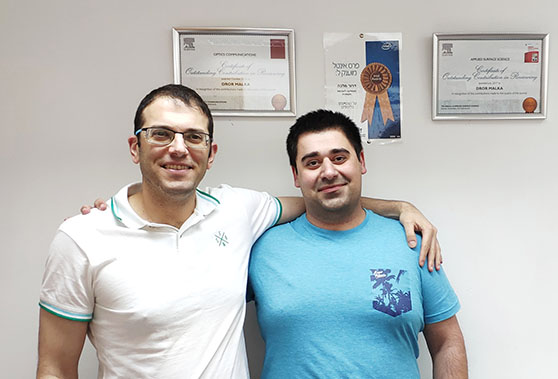More:
News & Stories
A Faculty of Engineering student's paper published in Optics & Laser Technology
Rami Dadabayev, Master's degree student at the Faculty of Engineering at HIT, has published, for the second time, a paper in the prestigious Optics & Laser Technology Magazine.
The paper was written as part of his final project guided by Dr.Dror Malka from the faculty of Engineering.
Dr. Malka: "This is indeed an outstanding achievement, because this is the first time where a Master's degree student published 2 articles in a magazine with a Q2 level in optics and Q1 level in Engineering (IF=2.5).

Dr. Dror Malka and Rami Dadabayev
Abstract:
One of the best ways to answer the growing demand for increasing data bit rate is by using visible light communication combined with wavelength division multiplexing technology. nowadays all the components that are capable of DE multiplexing wavelengths for VLC systems are based on optical bulk components that consist of lenses and filters, this fact causes VLC systems to be limited by size and performance.
Polymer fibres are very common nowadays and they are an excellent and cheap substitution for the glass fibres whenever we need to transmit a signal to a short distance, for example communication inside a building, a plain or car. Polymer fibres have an advantage compared to the traditional glass fibres due to their ability to stand larger bending and stretching forces and their lower price that allow to build communication system infrastructures with low cost.
We propose a novel design for an RGB DE multiplexer based on Polycarbonate (PC) multicore Polymer optical fiber (POF) structure with CYTOP as the background material.
The new design is based on adding PC rods along the fiber length that enable the controlling of the coupling length size between neighbouring cores. The locations of the rods and the geometrical parameters of the POF were analysed and simulated utilizing the beam propagation method (BPM) combined with MATLAB codes.
Results show that RGB operated wavelengths can be DE multiplexed after light propagation of 20 mm with an excellent crosstalk of −19.436 to −26.471 dB with a large bandwidth of 5.6–11.3 nm and low attenuation range of 0.828 to 1.246 dB.
Posted: 02/05/2019
- News & Events
New Collaboration with Sheba Medical Center will qualify nurses to work in a digital environment.
Collaboration between HIT Holon Institute of Technology, the teaching authority of the Sheba Medical Center, and the Sheba-BEYOND virtual hospital will allow training nurses in Israel and around the world to work in a digital...



 Additional programs
Additional programs
